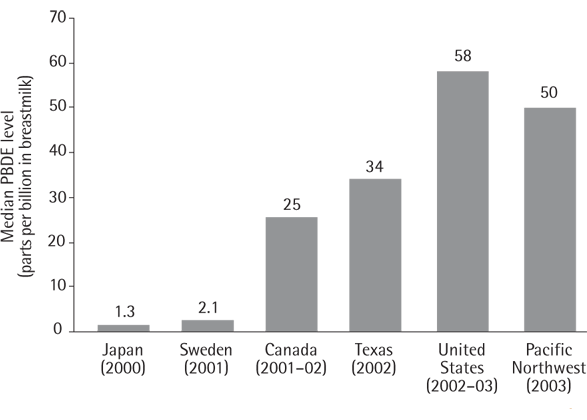Evidence from many sources—including an analysis of Cascadians’ breastmilk—shows that residents of the Pacific Northwest carry a thin soup of synthetic toxic chemicals in their bodies. Many of these compounds simply did not exist, or were present in only the most minute quantities, before the 20th century. But determining whether the concentrations of such chemical “body burdens” are rising or falling would require a comprehensive, long-term system of testing Cascadia’s human residents for the presence of toxic chemicals. At present, no such program exists.
As a first step towards gauging the nature and extent of these chemical “body burdens,” Sightline tested for the presence of two classes of long-lived toxic chemicals—PCBs and PBDEs—in human bodies, as manifested in mother’s milk. Like a number of hazardous chemicals, these compounds are considered “persistent bioaccumulative toxics”: they are harmful to living things, they break down slowly, and they build up over time in living tissue.
Both PCBs and PBDEs can harm neurological development and the immune system of laboratory animals. Long-term studies have found that children who were exposured to high levels of PCBs in the womb can suffer from subtle learning and memory deficits. And high levels of PBDEs and PCBs have even been correlated with reduced genital size in polar bears. Though banned in the 1970s, PCBs remain ubiquitous in soils, sediments, and living things. Because the compounds are attracted to plant and animal fats, they concentrate at each successive link in the food chain, reaching high levels in top predators such as orcas and humans.
PCBs were once prized by industry for their chemical stability—a quality that also makes them slow to degrade once released into the environment. Levels of PCBs in the environment seem to have declined somewhat since their manufacture was banned. But Washington’s Puget Sound, with its history of industry and manufacturing, is considered a hot spot for PCB contamination. In March 2006, the Washington Department of Health took the unusual step of warning consumers to limit consumption of chinook salmon from Puget Sound to one meal per week, in part because of high levels of PCBs. (The fish also contain high levels of mercury.) Chinook tested from Puget Sound had up to six times more PCBs than chinook caught elsewhere on the West Coast.
PBDEs are chemical cousins of PCBs that until recently were used as flame retardants in furniture foams. PBDE concentrations have been on the rise throughout most of the industrial world for decades, with high (and rising) levels found in the bodies of North Americans. (Click here for a chart of North American PBDE trends.)
In 2004, Sightline investigated the levels of PCBs and PBDEs in Cascadians’ bodies by testing breastmilk samples from 40 first-time mothers with young infants. The findings were alarming: both compounds were present in every sample tested. Among the 40 samples, the median (midpoint) concentration was 134 parts per billion of PCBs, and 50 parts per billion of PBDEs—a level of PBDEs that is 20 to 40 times higher than typically has been found in northern Europe and Japan.
 Sightline tested breastmilk, rather than blood, because human milk is high in the fats to which PCBs and PBDEs adhere; because it can be collected noninvasively; and because results from breastmilk tests can serve as a proxy for the toxic levels, or “body burdens,” of similarly aged men and nonbreastfeeding women. Sightline’s findings do not alter an important fact: breastmilk is far and away the healthiest food for infants.
Sightline tested breastmilk, rather than blood, because human milk is high in the fats to which PCBs and PBDEs adhere; because it can be collected noninvasively; and because results from breastmilk tests can serve as a proxy for the toxic levels, or “body burdens,” of similarly aged men and nonbreastfeeding women. Sightline’s findings do not alter an important fact: breastmilk is far and away the healthiest food for infants.
 Roughly one-third of the breastmilk samples Sightline tested had higher levels of PBDEs than PCBs, suggesting that the health threats from PBDEs may gradually be overtaking those from PCBs. And there’s no firm evidence that PBDE contamination has plateaued. A 2006 analysis of the blood of ten Washington residents also found PBDEs in every sample, at concentrations comparable to those in the 2004 breastmilk samples.
Roughly one-third of the breastmilk samples Sightline tested had higher levels of PBDEs than PCBs, suggesting that the health threats from PBDEs may gradually be overtaking those from PCBs. And there’s no firm evidence that PBDE contamination has plateaued. A 2006 analysis of the blood of ten Washington residents also found PBDEs in every sample, at concentrations comparable to those in the 2004 breastmilk samples.
Fortunately, North Americans have begun to take a more precautionary approach toward PBDEs. The US Environmental Protection Agency reached an agreement the chemicals’ manufacturers to halt production of the most troublesome forms of the compounds. In 2005 an Oregon bill banned the use of the most toxic forms of PBDEs in the state starting in 2006. Likewise, Canada announced in 2006 that it would add all forms of PBDEs to its national list of toxic substances, which may make them subject to additional regulations. In Washington, the state health and ecology agencies recommended a near-total ban of the compounds, and in early 2007 the Washington legislature voted overwhelmingly to follow those recommendations.
If the ban of PBDEs proves effective, concentrations of the compounds in human bodies will gradually wane. That success may teach us to take greater initiative in combating toxics, by requiring that potentially hazardous compounds be tested for safety before they are used widely.








